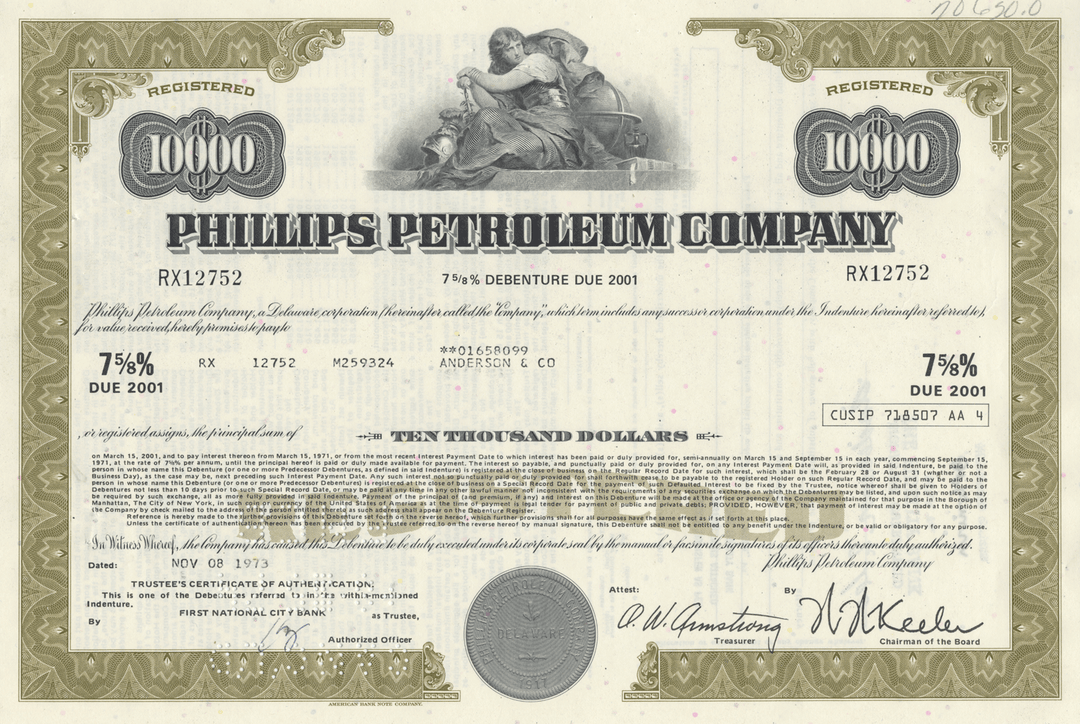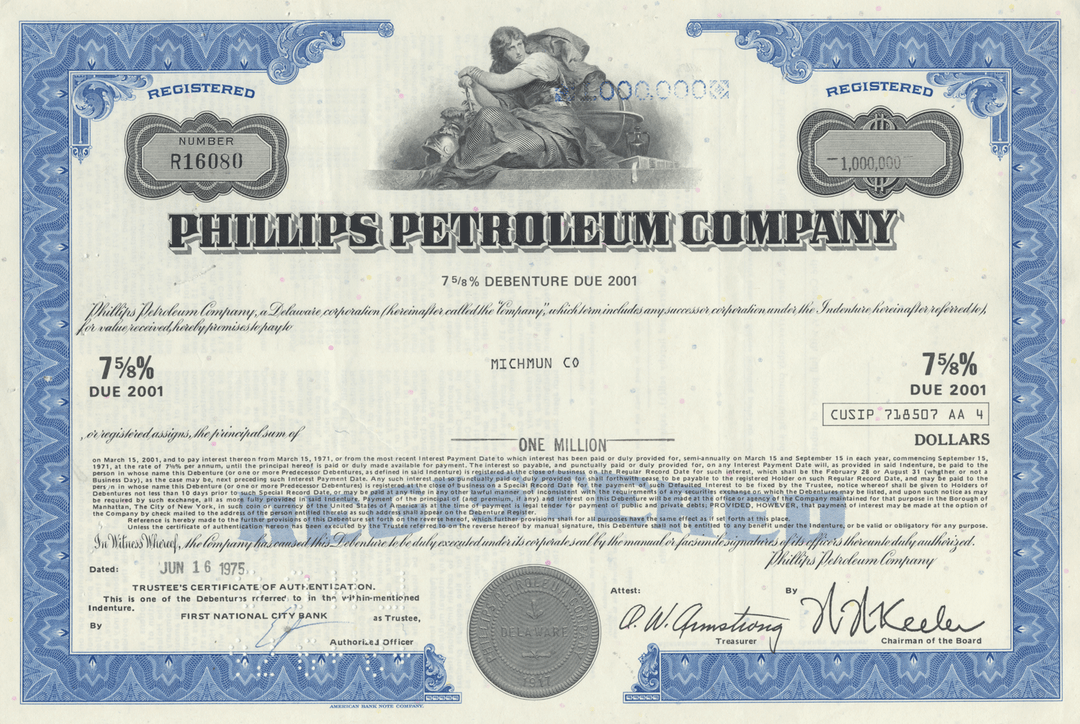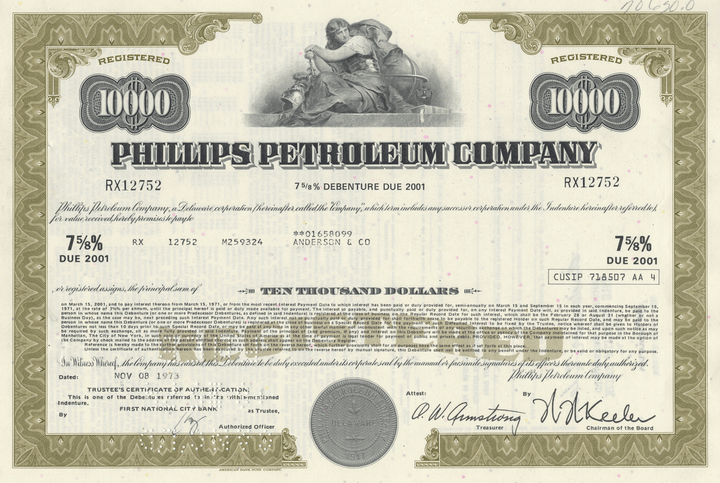Phillips Petroleum Company
- Guaranteed authentic document
- Orders over $75 ship FREE to U. S. addresses
Product Details
CompanyPhillips Petroleum Company
Certificate Type
Debenture Bond
Date Issued
1970's
Canceled
Yes
Printer
American Bank Note Company
Signatures
Machine printed
Approximate Size
12" (w) by 8" (h)
Images
Representative of the piece you will receive
Guaranteed Authentic
Yes
Additional Details
NA
Historical Context
The Phillips Petroleum Company was incorporated on June 13, 1917, by brothers Lee Eldas Phillips and Frank Phillips, of Bartlesville, Oklahoma. Their younger brother, Waite Phillips, was the benefactor of Philmont Scout Ranch. The company was headquartered in Bartlesville.
Phillips Petroleum rapidly became a fully integrated oil company that included oil and gas production, crude oil pipelines and refineries, and marketing of petroleum products.
Phillips Petroleum became heavily involved in the natural gas industry immediately after the discovery of the Panhandle gas field of Texas and the Hugoton field in Kansas. By 1925, it was the largest producer of natural gas liquids in the United States.
In 1927, Phillips started up its first petroleum refinery in Borger, Texas, designed to produce gasoline as an automotive fuel. The refinery also produced other petroleum fractions (e.g., kerosene, fuel oils). It opened its first service station, to sell gasoline, in Wichita, Kansas on November 19, 1927. In 1930, the company developed its "Phillips 66" trademark: according to company lore, a Phillips official was road-testing the company's newest gasoline, commented that the car was going "like 60" when his driver replied "Sixty nothing ... we're doing 66!", all while driving on U.S. Highway 66 in Oklahoma near Tulsa, resulting in the number 66 superimposed on the U.S. Highway symbol for Route 66.
Frank Phillips served as president of the company until 1938. He then turned over the presidency to Kenneth S. "Boots" Adams, but continued as chairman of the board until 1949, when he was 76 years old.
In 1942, the company bought more than 250,000 acres in the Hugoton-Panhandle gas fields and a 25 percent interest in the Panhandle Eastern Pipeline Company. In 1954, the U.S. Supreme Court decided the landmark case of Phillips Petroleum vs. State of Wisconsin which held that under the Natural Gas Act, the federal government should regulate the prices which natural gas producers charge when selling gas at the wellhead. Phillips then divested itself of the Panhandle Eastern Pipeline Interest, but remained a major supplier of natural gas.
World War II greatly stimulated the demand for petroleum products, especially high-octane aviation fuel and jet fuel. Phillips turned to technology to increase the octane rating of fuels for use in advanced engines. The company invented an HF alkylation process in 1940. The American petrochemical industry took off, first making such as styrene, ethylene, propylene and butadiene. After the war, it formed a subsidiary, Phillips Chemical Company, which entered the fertilizer business by producing anhydrous ammonia from natural gas. The company then built a complex on the Houston Ship Channel devoted to making petrochemicals and polymers.
During the 1960s, Phillips expanded its international operations, particularly with exploration in Canada, Venezuela, and Colombia. It discovered the Ekofisk gas field in the North Sea in 1969.
In 1966, Phillips Petroleum bought Tidewater Oil Co.'s West Coast operations and rebranded its "Flying A" outlets to Phillips 66.
In 1983, Phillips Petroleum bought the General American Oil Company, a Delaware company that was headquartered in Dallas. The company was originally built by Algur H. Meadows in 1936 through a merger with oilman J. W. Gilliland and General American Finance System, a company Meadows formed with Ralph Trippett and Henry W. Peters in the early 1930s.
In late 1984, Mesa Power LP Company, led by T. Boone Pickens Jr., attempted a hostile takeover of Phillips Petroleum. After Mesa failed, Carl Icahn attempted a separate hostile takeover. Phillips remained an independent company but recapitalized with greater debt. This large debt caused Phillips Petroleum to begin selling many of its assets, including refineries, and led to the 2002 merger with Conoco.
Phillips Petroleum Corp. and Chevron Corp. combined their worldwide chemical businesses in 2000 to form a new company, Chevron Phillips Chemical Corp., LLC. This excluded Chevron's oronite additives, which remained with its former parent. Chevron Phillips is headquartered in The Woodlands, Texas.
Related Collections
Additional Information
Certificates carry no value on any of today's financial indexes and no transfer of ownership is implied. All items offered are collectible in nature only. So, you can frame them, but you can't cash them in!
All of our pieces are original - we do not sell reproductions. If you ever find out that one of our pieces is not authentic, you may return it for a full refund of the purchase price and any associated shipping charges.









